Wine Lister’s partner critic platform, JancisRobinson.com has now released the majority of its scores for the 2020 vintage, helping to paint a better picture of some of the top en primeur picks.
Explore all Bordeaux 2020 scores here, or read more below.
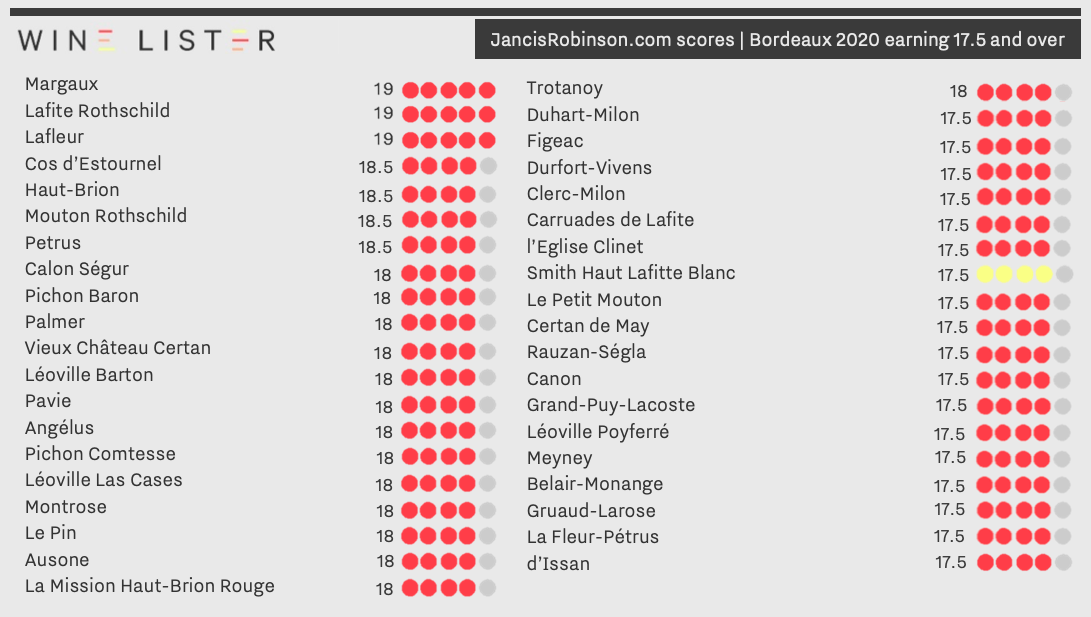
With a shared score of 19 from James Lawther for JancisRobinson.com, First Growths Margaux and Lafite lead the pack alongside Pomerol’s beloved Lafleur. Lawther describes Margaux 2020 as “aromatically complex with floral, mineral and dark-fruit notes”, and notes that Lafite 2020 is “rich, but with a massive charge of fine-grained tannin and lingering freshness” on the palate.
Fellow First Growths Haut-Brion and Mouton follow shortly after with a score of 18.5, shared with Lafleur’s neighbouring property, Petrus, and Saint-Estèphe staple, Cos d’Estournel.
Pomerol represents eight out of the 39 wines earning 17.5 and over from the JancisRobinson.com critics, recalling sentiments that earlier-ripening Merlots fared best in the latest vintage. Joining Lafleur and Petrus, Vieux Château Certan, Le Pin, Trotanoy, l’Eglise Clinet, Certan de May, and La Fleur-Pétrus earn a score of 17.5 for their 2020s.
Smith Haut Lafitte Blanc is the only dry white Bordeaux to gain a score of 17.5 and above from JancisRobinson.com critics so far. Robinson tasted the wine herself, and observes that it is “already gorgeous” with “some richness on palate entry” that “gives way to really fantastic vibrancy on the palate”.
Also featured in the list of Bordeaux 2020s earning 17.5 and over from Wine Lister partner critic platform, JancisRobinson.com are: Calon Ségur, Pichon Baron, Palmer, Léoville Barton, Pavie, Angélus, Pichon Comtesse, Léoville Las Cases, Montrose, Ausone, La Mission Haut-Brion Rouge, Trotanoy, Duhart-Milon, Figeac, Durfort-Vivens, Clerc-Milon, Carruades de Lafite, Le Petit Mouton, Rauzan-Ségla, Canon, Grand-Puy-Lacoste, Léoville Poyferré, Meyney, Belair-Monange, Gruaud-Larose, and d’Issan.
Explore the top Bordeaux 2020 scores from Bettane+Desseauve, Neal Martin and Antonio Galloni (Vinous), and Jeannie Cho Lee.
The majority of Bordeaux 2020 en primeur scores have now been published by Wine Lister partner critic, Bettane+Desseauve, offering further insight into some of the best bottles from the latest vintage.
Explore all Bordeaux 2020 WL scores here, or read more below.
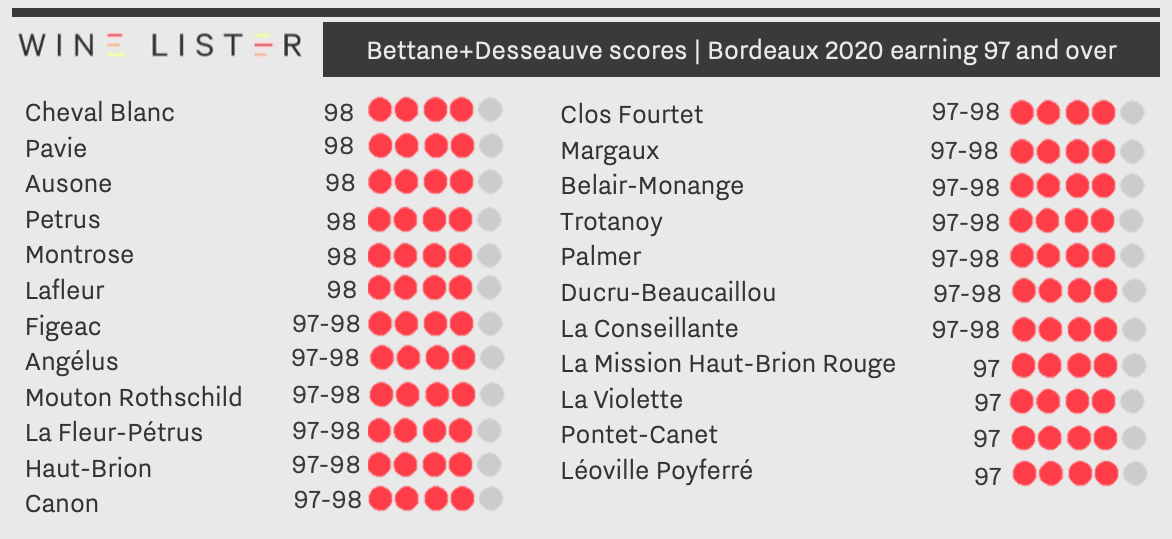 Note that this year Bettane+Desseauve’s scores are officially ranked on a 100-point scale, as shown above. For consistent and comparable analysis with previous vintages, Bettane+Desseauve have provided 20-point scores to be displayed on individual Wine Lister wine pages during the transition into their new system.
Note that this year Bettane+Desseauve’s scores are officially ranked on a 100-point scale, as shown above. For consistent and comparable analysis with previous vintages, Bettane+Desseauve have provided 20-point scores to be displayed on individual Wine Lister wine pages during the transition into their new system.
Five of the six wines that receive a score of 98 from Bettane+ Desseauve this year hail from the Right Bank, with Cheval Blanc, Pavie, Ausone, Petrus, and Lafleur leading the list. This adheres to initial indications that it is a Right Bank year, with earlier-ripening Merlot, partnered with the soil’s increased water-holding capacity, helping it handle the drought during the summer.
Indeed, a further five wines on the list come from Saint-Emilion, whose limestone terroirs encouraged a steady water table for the vines in 2020. Figeac, Angélus, Canon, Clos Fourtet, and Belair-Monange all score an impressive 97.5 with their latest vintages.
Pomerol also provides a further four picks, with La Fleur-Pétrus, Trotanoy, and La Conseillante gaining 97.5, followed by micro-production La Violette (releasing 4,800 bottles in 2020) with 97 points.
Also featured on the list of Bordeaux 2020s earning 97 and over from Wine Lister partner critic, Bettane+Desseauve are: Mouton Rothschild, La Fleur-Pétrus, Haut-Brion, Margaux, Palmer, Ducru-Beaucaillou, La Mission Haut-Brion, Pontet-Canet, and Léoville Poyferré.
Explore the top Bordeaux 2020 scores from JancisRobinson.com, Neal Martin and Antonio Galloni (Vinous), and Jeannie Cho Lee.
As we approach the end of May, the Bordeaux 2020 en primeur campaign is still yet to kick off in full force. The past week has seen a slight lull in en primeur activity, with a selection of mid-level wines trickling onto the market.
Following Pentecost Monday, releases commenced on Tuesday (25th May), with Berliquet 2020 entering the market at £36.25. In the expert hands of Canon and Rauzan-Ségla‘s Nicolas Audebert since 2017, Berliquet is fast becoming a true Saint-Émilion gem to watch. Wine Lister CEO, Ella Lister, notes that she was “totally wowed by this wine – Berliquet’s best yet, on a vertiginous ascent”, detecting “flower pollen, verveine, fennel, and chamomile” on the nose, and a “grounded but melting” texture on the palate.
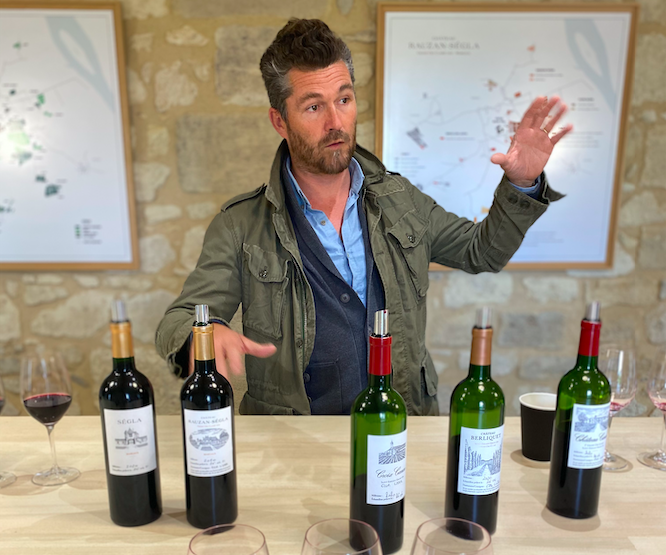 Nicolas Audebert – Winemaker at Rauzan Segla, Canon, and Berliquet (who released its 2020 vintage on Tuesday 25th May)
Nicolas Audebert – Winemaker at Rauzan Segla, Canon, and Berliquet (who released its 2020 vintage on Tuesday 25th May)
A trio of Margaux properties released their latest vintages on Wednesday morning (26th May), with Kirwan, Prieuré-Lichine, and Marquis de Terme 2020 entering the market in quick succession. At £25.37, Prieuré-Lichine’s latest release falls under the price of all recent back vintages in the market, while a score of 17 from Julia Harding for JancisRobinson.com places it in line with the well-regarded 2019 vintage. Offering good value for quality, the 2020 is described by Julia as “fragrant with the intense aromas of cassis and spicy black plum”, with a full palate that remains “nicely dry and fresh on the finish”.
Added to the mid-week haul is another Margaux estate, du Tertre, who this year received its highest ever score from Julia Harding for JancisRobinson.com (17+). Ella was also impressed by the latest release, which entered the market yesterday (Thursday 27th May), describing “charming, meandering fruit on the palate”. Having been sold by AJ Domaines (owners of fellow Margaux property, Giscours) this year, du Tertre is now under the helm of the Helfrich family, who have hired Cynthia Capelaere (formerly of Villemaurine) as the new Estate Director. As we often see following the sale and acquisition of an estate, this may be one to watch for future investment as it is revitalised by its new owners.
Also released yesterday, Quinault l’Enclos 2020 was described by Ella as “the culmination of the Cheval Blanc team’s work at this property since its acquisition in 2008”. Tasting in Bordeaux, she notes that “the trademark smoked notes have been relegated to the merest hint”, with “rich, dapper fruit” on the nose, and a palate with an “exceptional light-tough and melting mouthfeel”.
Also released this week are: Cantemerle, Chasse-Spleen, Château Les Cruzelles, Grand Corbin-Despagne, Larrivet Haut-Brion, Kirwan, and La Lagune.
As another week of Bordeaux 2020 en primeur releases draws to a close, the campaign has begun to show signs of speeding up, with some compelling releases entering the market over the past three days.
Below we examine releases from Laroque (Wednesday 19th), Lafon-Rochet (Thursday 20th), and Branaire-Ducru and Batailley (Friday 21st).
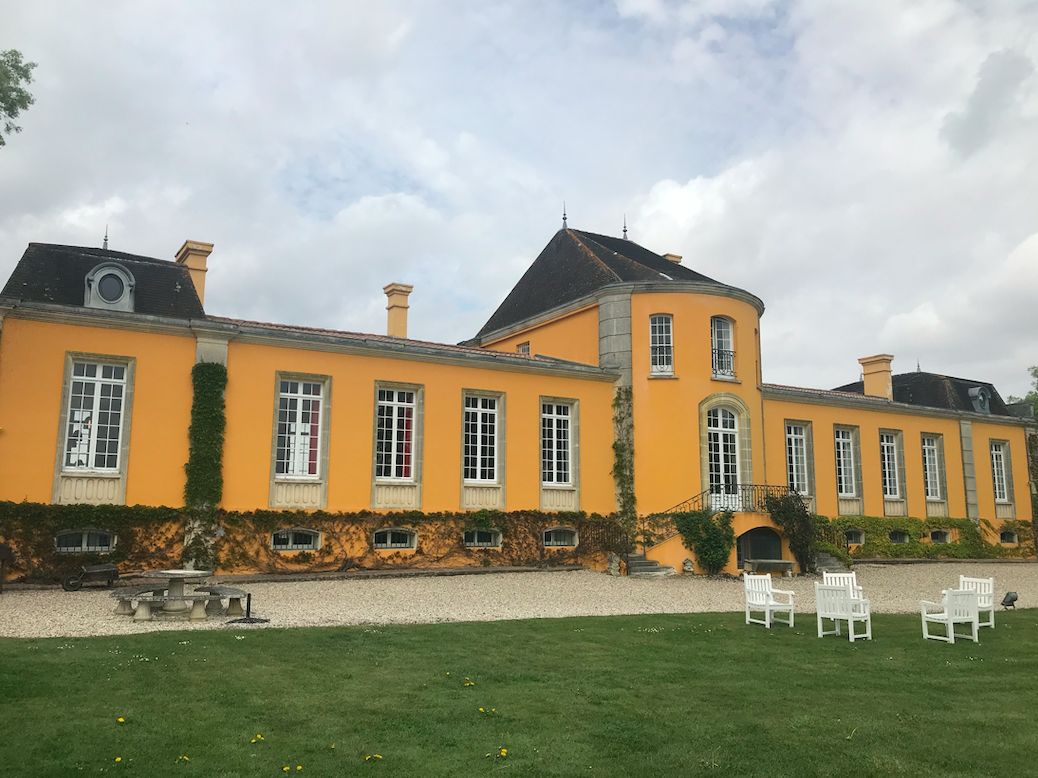 Lafon-Rochet’s latest release is a “very successful 2020”, according to Wine Lister partner critic, Jancis Robinson
Lafon-Rochet’s latest release is a “very successful 2020”, according to Wine Lister partner critic, Jancis Robinson
Released at £18.95 per bottle (in-bond), Laroque was described by Wine Lister CEO, Ella Lister as having an “ebullient, classy, very cassis nose”, developing into a “serious, structured wine on the palate”. The estate has seen recent improvements and investments to achieve a higher quality, starting with the hiring of David Suire in 2015, and the 2020 is no exception in the recent pattern of excellent value for money.
Lafon-Rochet’s latest vintage also illustrates the property’s upward quality trajectory. Having been awarded 17 points from Wine Lister partner critic, Jancis Robinson, (up from 16.5+ for the 2019) she describes it as a “very successful 2020” and congratulates owner, Basile Tesseron, for “producing something so appetising and groundbreaking”. Entering the market yesterday at c.£27.10 per bottle (in-bond), the vintage marks a year of development at Lafon-Rochet. As well as embarking on an agroforestry scheme in 2020 to enrich its environment, the latest release marks the inaugural collaboration of Jean-Claude Berrouet and Eric Boissenot, who worked together on its blending (recap our blog here). The price positioning of this top-quality vintage 10% below the 2019 market price has reportedly been very well-received.
Cru Classés Branaire-Ducru and Batailley were released this morning. Having made a name for itself as offering exceptionally good value within the Saint-Julien appellation, Branaire-Ducru’s latest release (at £31 per bottle in-bond) enters the market at an average 11% and 22% below than current availability of the 2019 and 2018 respectively.
Writing for JancisRobinson.com, James Lawther awards Batailley 2020 17 points, describing it as “Solid, subdued and distinctly Pauillac”. At c.£28 per bottle (in-bond), it enters the market under current average market prices of the last six vintages.
Keep track of en primeur releases on Wine Lister’s dedicated En Primeur Page here.
With the 2020 en primeur campaign now in full swing, the past two days have seen releases from the likes of Angélus, the Barton family, the Perse family, and more.
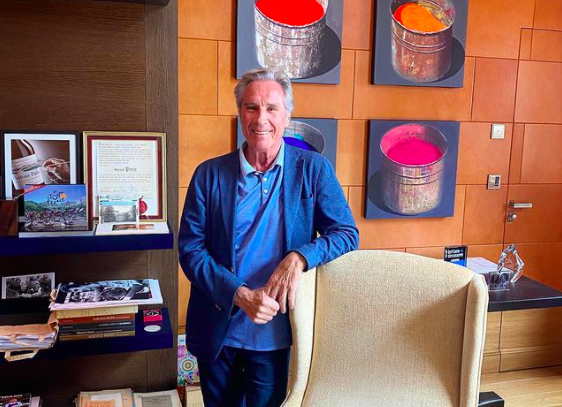 “Another big step in the right direction for this château in revealing its excellent terroir” – Wine Lister, CEO Ella Lister, who visited Pavie’s owner, Gérard Perse (pictured) last year
“Another big step in the right direction for this château in revealing its excellent terroir” – Wine Lister, CEO Ella Lister, who visited Pavie’s owner, Gérard Perse (pictured) last year
Released yesterday morning (Tuesday 18th May), the latest vintage of the Barton family wines – Léoville Barton, Langoa Barton, and Mauvesin Barton – has reportedly seen a positive uptake in the UK market already. Wine Lister partner critic, Jancis Robinson, gives high praise to the flagship release, Léoville Barton, awarding it 18 points, and noting that it shows “very fine winemaking indeed”, adding, “I have to admit I was tempted to swallow this, it was so majestic”. Wine Lister’s CEO, Ella Lister, also commends the latest vintage, describing a “sculptured structure which takes it into a different register”. The 2020 was released at £60.80 per bottle in-bond – over 10% higher than last year’s release, but potentially sporting the wine’s best quality to date.
Two more Saint-Émilion Grand Crus Classés “A” have joined fellow comrade and early-bird release Cheval Blanc, with Angélus entering the market at £254 per bottle (in-bond), and Pavie following closely behind at c.£241 per bottle (in-bond).
The latter gained resounding praise this year: James Lawther (for JancisRobinson.com) notes “absolute precision” which he says “more than highlights the change in style,” concluding, “one of the best yet”. Ella echoes this sentiment, asserting that “delightful floral freshness and a feather-light texture mark another big step in the right direction for this château in revealing its excellent terroir,” and calling the wine ”complex and refined”. The comments combined suggest that Pavie 2020 is the culmination of stylistic changes undertaken by the property over the last few years.
Perse family sibling, Pavie-Decesse 2020 was also released yesterday at £83 per bottle (in-bond). The latest vintage gains 17 points from James Lawther, who describes “Tension and minerality as well but plenty of charm this year”. With virtually no stocks of last year’s release remaining on the market, and the estate offering an element of rarity (at 3.5ha, it is a 10th of the size of Pavie), the latest release is likely to gain appeal beyond its volume released.
Also released so far this week are: Marquis d’Alesme, Labégorce, Coutet, Guiraud, Bellevue-Mondotte, and Monbousquet.
With the bank holiday weekend approaching, Wine Lister has selected 10 mature Bordeaux MUST BUYs that promise to please with your Easter Sunday lunch. Boasting at least nine years of ageing, these top picks are available to purchase for under £100 (per bottle in-bond, when purchasing by the case in general).
Check out all of our Bordeaux MUST BUYs here, or read more below.
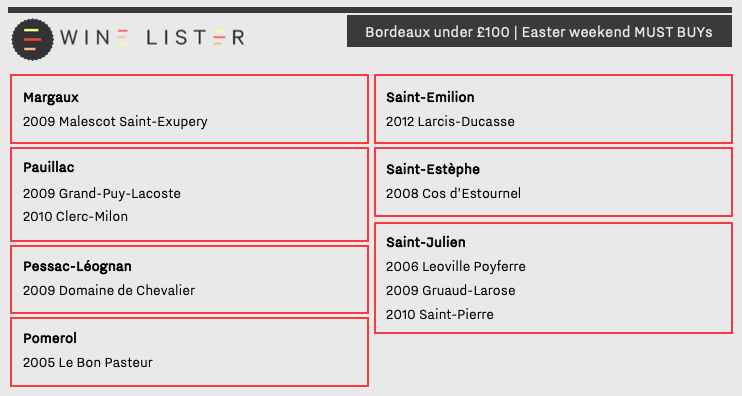
Regarded as a top-quality year for Bordeaux across appellations four of the 10 MUST BUY picks hail from 2009. Following a wet spring that provided plentiful water reserves, the summer of 2009 saw almost perfect growing conditions with minimal disease pressure, and many great wines from the vintage are beginning to either their optimum drinking window.
Described by Wine Lister partner critic, Jancis Robinson, as “very winning and opulent” with “massive volume and finish”, Margaux’s Malescot Saint-Exupery achieves a WL score of 93 in 2009. The property has exhibited an upward quality trajectory since the turn of the century, with the legendary Michel Rolland consulting on its production of a single, unfiltered and unfined wine. The 2009 vintage can be purchased from Fine+Rare for £71 per bottle (in-bond).
Grand-Puy-Lacoste’s 2009 vintage receives 18 points from Robinson, who notes; “a very sweet start. Herbal and interesting. Lots of fine tannin and savour. Very distinctive and ambitious”. Marking the estate’s highest WL score since its 1990 vintage (94), the 2009 is available to purchase from Bordeaux Index for £59 per bottle (in-bond).
Another classic left bank brand, Gruaud-Larose’s 2009 is described by Wine Lister partner critic, Neal Martin (Vinous), as offering refined aromas of “blackberry, cedar and leather”, and a “fine bead of acidity [with] great precision on the brown spice infused finish”. Hailed for the longevity of its wines, this can be enjoyed now, or aged for at least 10 more years. It is available from Bordeaux Index for £81 per bottle (in-bond).
Moving across to the right bank and back a few vintages, 2005 Le Bon Pasteur achieves the property’s highest ever WL score (94), and is described by Wine Lister partner critic, Bettane+Desseauve as offering notes of “dark fruits and fine chocolate”, and a “refined tannic structure, brilliant length and freshness”. With over 15 years of age, and only 2,500 bottles released, it has limited remaining market availability, but can be sought out for £100 per bottle (in-bond) from Cru World Wine.
Slightly south in Saint-Émilion, our chosen younger offering from Larcis-Ducasse – the 2012 – is available from Cult Wines for £41 per bottle (in-bond), making it the least expensive of the group. While rain in October forced many left bank estates to pick their late-ripening Cabernet Sauvignon earlier, the predominance of Merlot on the right bank saw its wines perform comparably better in 2012. Wine Lister partner critic, Jeannie Cho Lee, describes the 2012 Larcis-Ducasse as an “elegant, full bodied red with opulent tannins and wonderful energy”.
Last but not least, Saint-Estèphe star Cos d’Estournel makes the cut for its 2008 vintage. Robinson describes it as “very luscious and round” with a “strong blackcurrant element” and “surprisingly gentle tannins”. Achieving a WL score of 94, it is available to purchase by the bottle from Lay & Wheeler for £88 (in-bond).
To mark the first day of spring (Saturday 20th March), this week’s blog takes a deep dive into Wine Lister’s latest MUST BUY update, helping you to discover some excellent wines to enjoy over the next few months. The 19 new MUST BUYs cover a range of regions, varieties, and styles, providing inspiration for top picks to drink now or put away for the future.
Click here to view all MUST BUYs, or read more below.
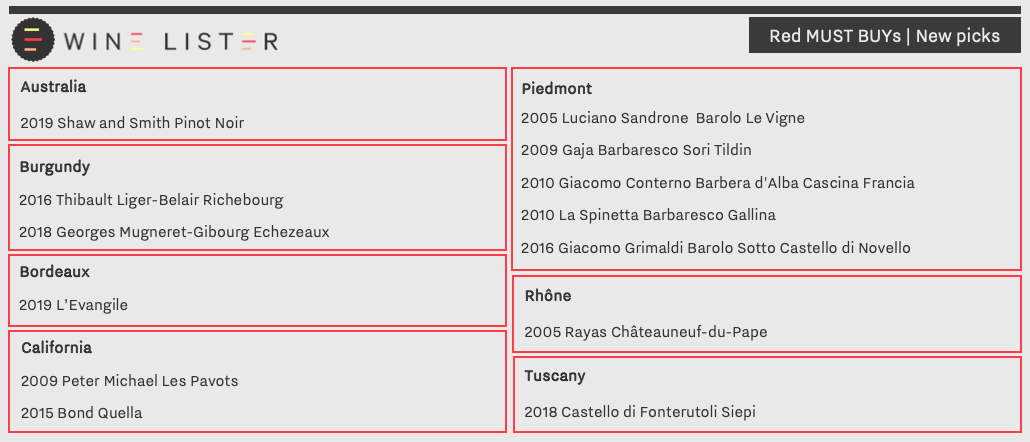
Piedmont constitutes over a quarter of the new MUST BUY picks, with entries from five of the region’s leading producers. Currently at its peak drinking, Luciano Sandrone’s 2005 Barolo Le Vigne comprises a blend of fruit from four of the estate’s top vineyards, each with different terroirs, altitudes, and exposures. Harvested, vinified, and aged separately, the final assemblage is intended to express the best characteristics of each plot. Wine Lister’s partner critic, Jancis Robinson, describes it as “complex”, with “already very integrated aromas”. It can be purchased from Farr Vintners for £79 per bottle (in-bond).
In Burgundy, Thibault Liger-Belair’s 2018 Richebourg achieves its highest WL score since the successful 2010 vintage (96), and is described by Wine Lister’s Burgundy specialist critic, Jasper Morris, as possibly “[Thibault’s] best Richebourg to date”. Awarding it 95-98 points, Jasper notes that “the oak […] is so suffused by a brilliant dense entirely red fruit, soft strawberry and more pronounced raspberry”. It is available to buy from Corney & Barrow for £450 per bottle (in-bond).
Representing the Southern Hemisphere, Shaw and Smith’s 2019 Pinot Noir also has Value Pick status, with a WL score of 92 at £26 per bottle (in-bond). The first vintage to include fruit from the property’s Lenswood vineyard, which boasts mature vines and high altitude, it marks an exciting development for Shaw and Smith. Richard Hemming for Jancis Robinson describes it at “superbly fragrant” and representative of “the sheer pleasure of the variety”. It can be bought from The Fine Wine Company.

Pierre-Yves Colin-Morey makes up two of three Burgundy whites to feature in the latest MUST BUY update, with its 2016 Meursault Perrières and 2018 Corton-Charlemagne. At £210 per bottle (in-bond), the former achieves 94 points from Jasper Morris, who notes “riper fruit, almost some orange blossom, but still an underlying freshness”. Meanwhile, Julia Harding for Jancis Robinson awards 19 points to the 2018 Corton-Charlemagne, describing it as “powerful and elegant” with a “smoky and quite subtle” nose. While both wines are more difficult to source, it is worth informing your merchant of your interest in purchasing them.
Other wines featured in the new MUST BUY selection are: 2005 Rayas Châteauneuf-du-Pape, 2009 Gaja Barbaresco Sori Tildin, 2009 Peter Michael Les Pavots, 2010 Giacomo Conterno Barbera d’Alba Cascina Francia, 2010 La Spinetta Barbaresco Gallina, 2014 Bouchard Père et Fils Montrachet, 2015 Bond Quella, 2016 Giacomo Grimaldi Barolo Sotto Castello di Novello, 2017 Gangloff Condrieu, 2017 Kistler Vineyards Hudson Vineyard Chardonnay, 2017 Kistler Vineyards McCrea Vineyard Chardonnay, 2018 Castello di Fonterutoli Siepi, 2018 Georges Mugneret-Gibourg Echezeaux, and 2019 l’Evangile.
Like many of the world’s winemaking regions, Barolo is increasingly subject to dramatic weather patterns as a result of global warming. With significant frost in spring followed by an extremely hot summer, its 2017 growing season was no exception to these severe shifts. Akin to its vines, Barolo’s producers are now more than ever demonstrating their resilience to change, as evident in its latest offerings.
To guide those buying Barolo 2017 over the coming weeks, Wine Lister has spoken to nine of the region’s top producers to get a better picture of the vintage and its viticultural demands.
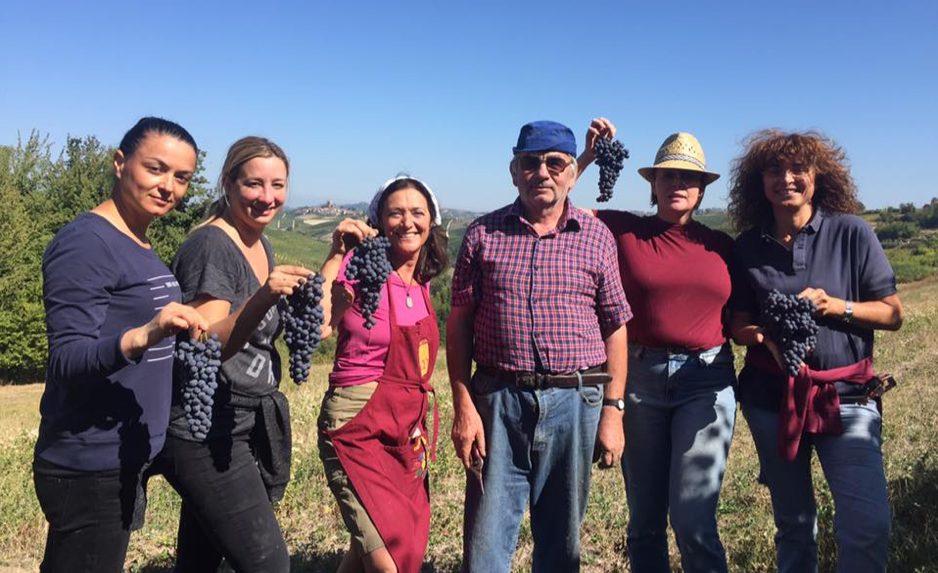 Chiara Boschis and her team during the 2017 harvest at E.Pira e Figli
Chiara Boschis and her team during the 2017 harvest at E.Pira e Figli
A reduction in production
As cited by several producers, spring frost and summer drought resulted in reduced yields across the board in 2017. Situated in the heart of Barolo, Chiara Boschis tells us that production at E.Pira e Figli was down between 10-20% on the 2016. The estate had to carefully select “clusters that were compact when picked”, as heat stress was preventing complete berry development. Marco Marengo notes that yields at his estate were 25% lower than average in 2017, while owner and winemaker at La Spinetta, Giorgio Rivetti, saw levels down by roughly 30%. A representative at Giacomo Conterno, Stephanie Flou tells us that its 2017 vintage was particularly affected by it being “the second year in a row in which [the estate] has suffered drought”. She states that while yields were limited “because the grapes dried out”, they are “positively surprised with how the vintage has ended up”.
Finding shade from the sun
Numerous estates noted the need for rigorous canopy management in 2017 – one of many adjustments applied across the region to cope with the extreme heat. Elio Altare’s second-generation winemaker, Silvia Altare tells us that hydric stress forced her to be amongst the vines, “meticulously managing the canopies to protect the grapes from the sun”. The team at Cantina Cooperativa Terre del Barolo also explain that this “was key in 2017 in order to keep bunches in shade, without suffocating them”, while “conservation tillage – mulching or grass covering in between the rows –was crucial to limit evaporation, and to protect the vines from the ‘mirror effect’ of the soil”. Vietti’s winemaker, Luca Currado notes that he similarly used “uniform, dense foliage to provide clusters with greater shade” and “grass cover between the rows to prevent sunlight reflecting directly onto the clusters”. The estate also started harvest significantly earlier than usual in 2017 – another recurring theme across the properties.
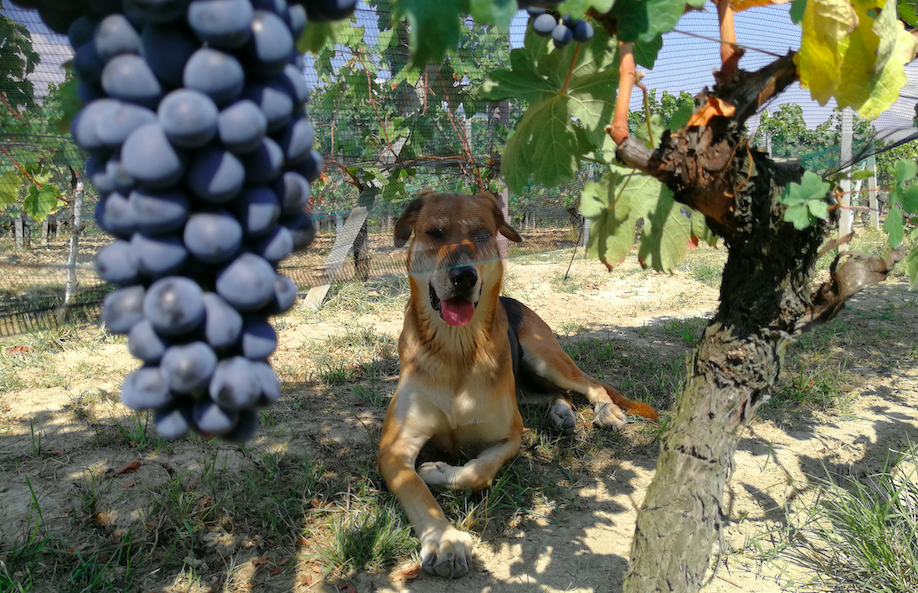 Keeping cool: the family dog at Elio Altare finds shade under the vines during the estate’s 2017 harvest
Keeping cool: the family dog at Elio Altare finds shade under the vines during the estate’s 2017 harvest
A crucial cooling
As mentioned by several of his peers, Azelia’s fifth-generation winemaker, Lorenzo Scavino tells us that a large diurnal temperature range helped to “preserve the freshness and the aromas of the grapes” in such a hot year. He states that while these cool nights “usually do not occur in warmer vintages, they were really a blessing”. Poderi Luigi Einaudi’s team echoed this sentiment, add that the temperature changes between day and night helped to develop the “polyphenolic profile of the Nebbiolo”, allowing “an excellent accumulation of tannins”. Rainfall in early September also helped to ensure balance in the 2017 vintage, with Luca Currado informing us that Vietti’s “Nebbiolo and Barbera benefited in particular, with highly complex polyphenolic profiles compared to other particularly rich vintages”, and “an unexpected freshness on the palate”.
The final freshness
Indeed, according to Wine Lister’s discussions with producers, freshness has been the great surprise of the 2017 vintage – a description applied repeatedly by Wine Lister’s partner critic, Antonio Galloni, in his notes on the region’s latest offerings. Chiara Boschis notes that E. Pira e Figli’s 2017 is “generous but very fresh”, while Azelia’s Lorenzo Scavino explains that rigorous vineyard management allowed them to “preserve the acidity, which is why even in this vintage we can find a great freshness”. Silvia Altare also tells us that while “2017 is definitely a warmer, more open knit vintage than 2016”, she has “noticed over the past few months the wines have integrated more and there’s a bit more freshness”.
The successful conception of balance in a year defined by drought aptly illustrates the resilience of Barolo’s producers in 2017, which may well be described as a winemaker’s vintage. Barolo 2017 scores have so far been high across the board, giving further merit to those who have created a wine of complexity and quality in a year of climatic uncertainty.
Keep track of new Barolo 2017 scores from Wine Lister’s partner critics here.
Home to a range of grape varieties, styles, and DOCGs, Tuscany also offers excellent wines at a variety of price points. To help you on your hunt for a top Tuscan bottle within your budget, Wine Lister has compiled a selection of Tuscany MUST BUYs at five different price points.
Click here to view all Tuscan MUST BUYs, or read more below.
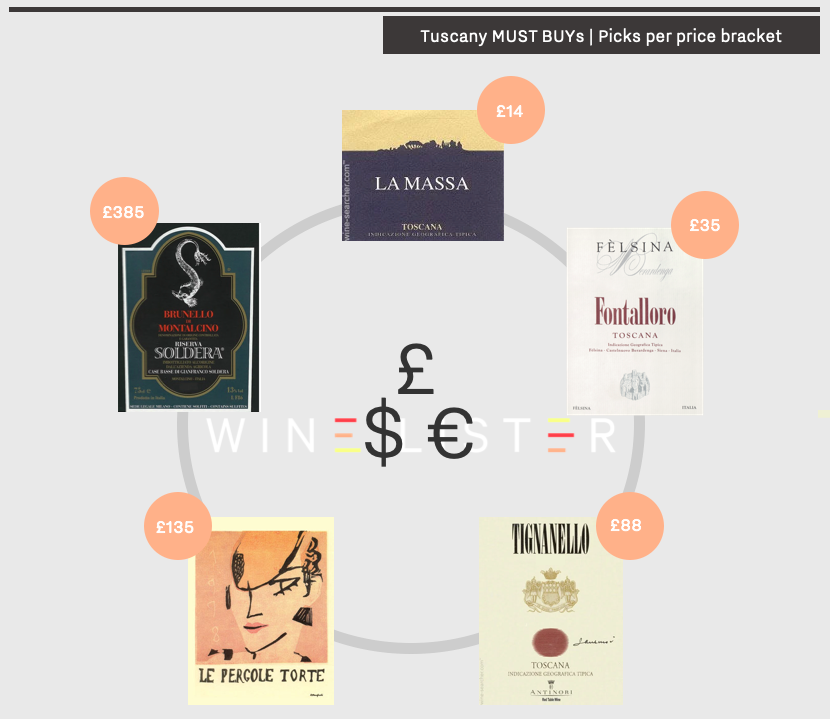 Prices are shown per bottle in-bond (when buying by the case).
Prices are shown per bottle in-bond (when buying by the case).
Under £20 – 2011 Fattoria La Massa La Massa
Founded in 1992 by prominent Chianti winemaker, Giampaolo Motta, Fattoria La Massa represents his aim of applying Bordeaux vinification techniques to a Tuscan terroir. With the counsel of famed Bordeaux vigneron, Stéphane Derenoncourt, Motta now grows Cabernet Sauvignon, Merlot, and Petit Verdot alongside native Sangiovese. La Massa comprises 60% Sangiovese, 30% Cabernet Sauvignon, and 10% Merlot in 2011, and is described by Wine Lister partner critic, Antonio Galloni as “jumping from the glass with dark red cherry, raspberry jam, plum, spices, violets, smoke and cloves”. With a WL score of 92, it is available to purchase from Bordeaux Index for £16 per bottle (in-bond).
Under £50 – 2015 Felsina Fontalloro
Felsina has seen a significant shift toward organic and biodynamic practices since its founder, Domenico Poggiali’s son-in-law, Giuseppe Mazzocolin, took over in the late 1970s. As well as investing heavily in a more natural viticulture, the estate has adopted a dedication to revealing the expression of its terroir. The 2015 Felsina Fontalloro was awarded 96 points from Antonio Galloni, who indeed notes that “sandy soils confer aromatic intensity to this super-expressive, arrestingly beautiful wine”. It can be purchased from Brunswick Fine Wines for £44 per bottle (in-bond).
Under £100 – 2016 Tenuta Tignanello Tignanello
Antinori’s Tenuta Tignanello property fared notably well in 2016, with its namesake wine, Tignanello achieving its joint-highest WL score alongside its 2015 vintage (98). Antonio Galloni describes the 2016 Tignanello as “flat out stunning”, and muses, “I don’t think there is another wine anywhere in the world made entirely from estate fruit that can match Tignanello for quality, consistency and value”. A blend of 80% Sangiovese, 15% Cabernet Sauvignon, and 5% Cabernet Franc, it can be acquired from Fine+Rare Wines for £92 per bottle (in-bond).
Under £200 – 2015 Montevertine Le Pergole Torte
Considered a difficult place for any agricultural production, Radda was an unusual location for Montevertine’s founder, Sergio Manetti to establish his property in 1967. In one of the highest and rockiest sites in Chianti Classico, its steep hills are now home to top-quality Sangiovese vines from which its three wines – Pian del Ciampolo, Montevertine, and Le Pergole – are produced. Antonio Galloni awards 97 points to the 2015 Montevertine Le Pergole Torte, calling it “deep, powerful and resonant […] exotically ripe and flamboyant, not to mention utterly captivating”. It can be bought from IG Wines for £129 per bottle (in-bond).
Over £300 – 2008 Soldera Case Basse Sangiovese
Achieving 18 points from Wine Lister’s partner critic, Jancis Robinson, Soldera’s 2008 Case Basse Sangiovese is described as “so different from most Brunello” with a “reserved nose of autumnal leaves”, and a “real tang on the end”. Having separated from the Brunello di Montalcino DOCG in 2006, all vintages from 2007 onwards are labelled as Toscana IGT. The 2008 marks a shift away from the estate’s usual vinicultural methods, having been aged for a period in stainless steel before bottling. Antonio Galloni notes that it is indeed “quite different from virtually every other wine made at Case Basse”. The 2008 Case Basse Sangiovese can be bought from Fine+Rare Wines for £387 per bottle (in-bond).
In an industry so defined by the art of its craft, the limit of crunching numbers often starts and ends for wineries in vat rooms and through lab panels. Wine Lister was founded on a guiding principle that while wine is a mystical liquid, that lives and breathes, that can transcend facts and figures and contribute mightily to the human experience, there are also plain truths to be found in data analytics for both consumers and producers alike. It is on this basis that we have built a strong following of website users – collectors eager to follow trends of the secondary market, and professionals keeping abreast of the latest analyses – but also liked-minded producer clients, who find value in Wine Lister’s benchmarking and bespoke analytics solutions.
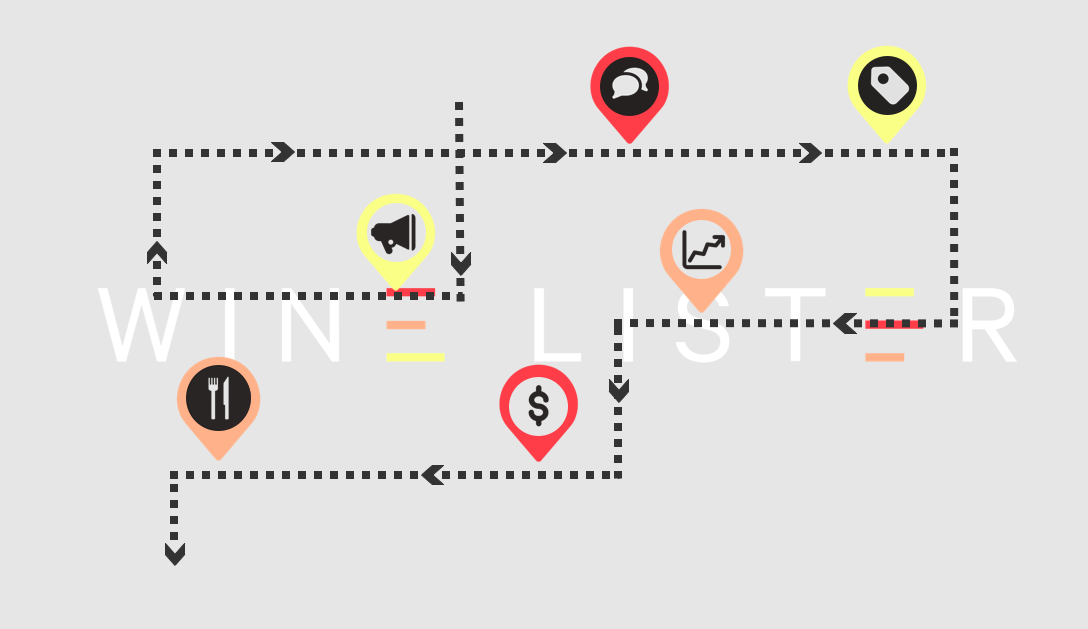
Wine Lister’s benchmarking solution relies on 14 separate data points across three areas in the life of a fine wine – Quality, Brand, and Economics – as well as qualitative trade panel feedback (through an unparalleled network from founder Ella Lister’s years as a fine wine journalist) to assess a wine’s 360° positioning in the global marketplace. Measured annually, Wine Lister’s benchmarking service enables continuous measurement of a wine within its global competitive environment, and results in a reliable, tangible reflection of progress, and ideas for the strategy path forward. Indeed, long-time Wine Lister client Don Weaver of Harlan Estate recently reflected that “It was a natural growth [to work with Wine Lister], another coming of age of our business… As we’ve matured as a business and penetrated further out into the market, we realised that we needed analytics coming back to us, and we needed best practices in our business. We can’t do everything, so we looked at Wine Lister to help us see things through different eyes.”
Such analytical rigour has resulted in numerous actionable insights for our clients, from assisting one client in increasing its journalistic coverage in a foreign market where it was underrepresented compared to peers, to a pricing strategy update for another that balanced the producer’s own interests while maintaining market confidence.
Once findings are identified, clients of Wine Lister can choose to investigate further, by supplying some of their own internal data to our analysts, enabling us to conduct deep-dives on topics as wide-ranging as customer retention, social media and communications effectiveness, or individual release price positioning. The benchmarking analysis is thus a base on which Wine Lister builds long-term relationships with its clients, helping them take their wine to the next level.
For more information, see our producer services page, or contact us for a free 30-minute consultation.











